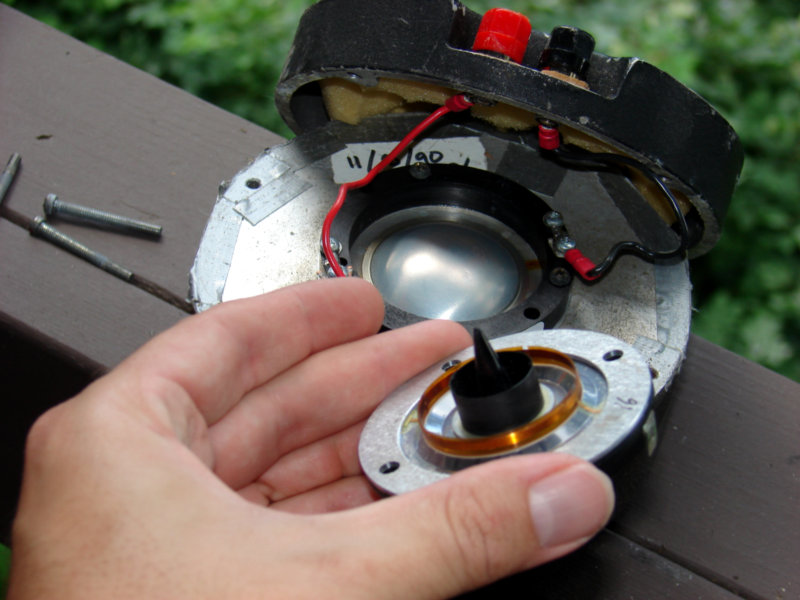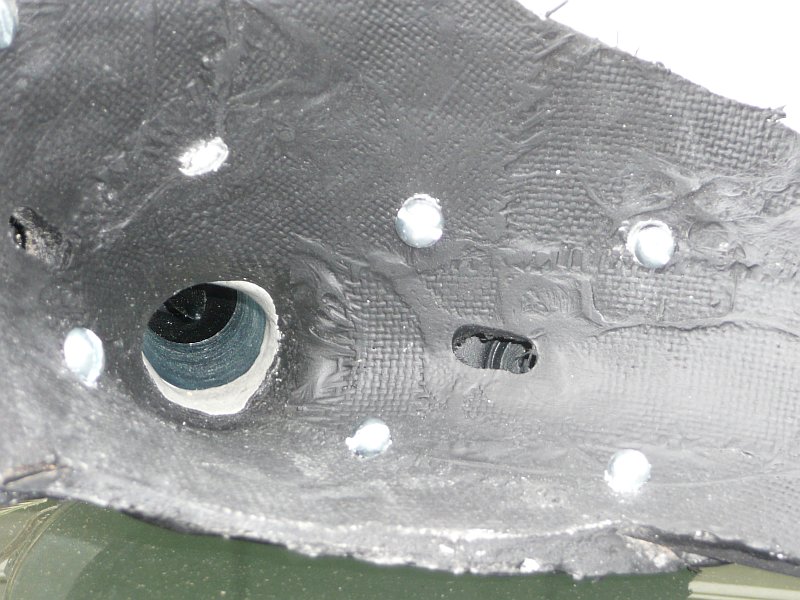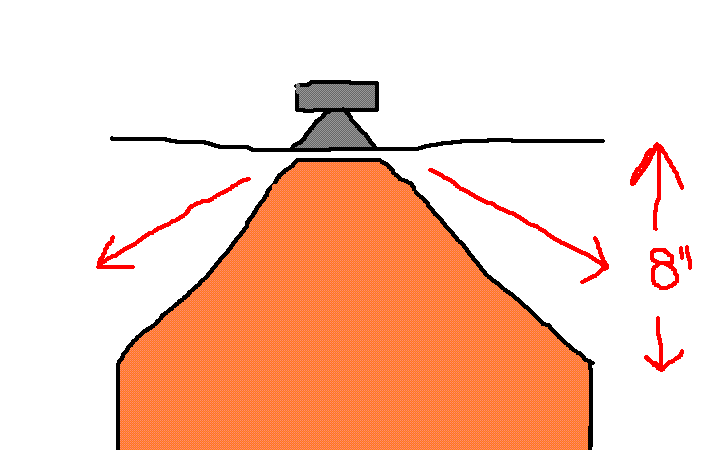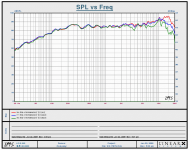Get a good nights sleep, everything will sound different in the morning.
Hi, That made me smile, I didnt know you could be fun
But I know what you mean, and its true
Just listened a bit again
But what I said actually holds, halfway
Only, its at low SPL
Turning up the volume and it does get a bit rough
Mind you this with just a randomly chosen series cap
I am confident that a proper xo will make it better
Also, mating it with a dedicated woofer, instead of using my 3ways, will probably also change the sound a lot
For good or worse I dont know
This combo is for my bass guitar
I just bought another pair of horns for the fun of it, and because they were cheap
I will most likely look at better drivers for further experiments with my stereo setup
And no, I have no intention of trying to compete with you
This thing will never be perfect
I diidnt expect other than "piezo-sound", but was very surpriced that it sound much better than expected
All in all, its just about having fun
CLS
This is just a small "teaser"
A dedicated thread will need more "meat on the bones"
But maybe I will get to that, some day
As you say, theres no available information on McGee
The waveguide is plain plastic, but it appears to be quite tough
Ofcourse I intend to strengthen it with foam and additional wood
Theres even an aluminium thread insert for the screw mount driver, which I didnt expect at this price
But the design around the troath is far from good
Strange that they dont seem to care much about it
Its a cast design, and it would have been easy to make it more smooth
Its obviously a skilled man who made the proto
But the people who made the mold for casting had no clew at all
So, the throath is pretty much messed up
As said, it will be easy to cut away the screw mount, and mount a plate instead
Maybe a 1.4" will have a better fit
To be honest
I bought the second pair just to see whether this horn thing would be anything for me
Now I dont doubt it is
I miss something every time I turn it off
I will definately try to make this work
Actually, my plan was to build a BIG version of this horn
I just dont have the time
And I have a friend who is interested in my RUBANOIDE plans, so thats definately going to happen
Last edited:
Oh yes. Very certainly yes. =)I am confident that a proper xo will make it better
Can we design and simulate an ultimate waveguide for a flat 3-4" piston without phase plug? Up to 1 meter long is possible. More people we find cheaper it will be. Within two weeks I will show my 400Hz prototype.
Ultimate as defined by who? And using what criteria? A 1 meter horn that big would be exceeding expensive to tool and fabricate. Is that not part of the "ultimate". I'm certainly capable of such a design and I might even be willing to do it, but I'd have to be clear what the design principles and priorities are. I can even have them made, but small batch fabrication in the US is very very expensive .
For a 25mm. piston the frequency is 15.89kHz., the radius times the square root of three.
If you look at the regions where the glitches occur you can see a distinct difference between the field in and outside the boundry between the duct and the infinite baffle.
Ideally the place inside the duct should be formulated as a finite element problem, the outside field by the boundary element.
In geophysical problems where the only data you can get is basically from boundaries, these glitches are dealt with by interpolation and statistical methods.
As Earl has pointed out what happens at the glitch is actually far more probably an average of what is happening either side of it, and the software might well have facilities for dealing with this in its more advanced facilities, I haven't investigated it myself however.
rcw.
Most compression drivers have a diaphragm whose size limits high frequency extenstion. The BMS 4540ND has a diaphragm which is much smaller than normal. Due to it's small size, you could probably get it to play to 30khz.
In a post here, I've taken one apart:
http://www.diymobileaudio.com/forum...creating-perfect-soundstage-4.html#post766693
Here's a pic



In the last pic, I've removed the bug screen, and you can see the phase plug peeking through.
You mentioned that you were interested in finding a compression driver with a 20 mm throat. You could insert a plastic sleeve into the BMS, and reduce the throat to 20mm with ease.
http://lh3.ggpht.com/_wUDOCViv9D0/Sq3-XafUQtI/AAAAAAAABJg/6qO7LMHuUWs/s800/sep14-9.jpg
Can we design and simulate an ultimate waveguide for a flat 3-4" piston without phase plug? Up to 1 meter long is possible. More people we find cheaper it will be. Within two weeks I will show my 400Hz prototype.
I've created a few ginormous waveguides, in an effort to cover the whole midrange. They're kinda neat for about five minutes, and then the distortion becomes unbearable.
The problem is that the waveguide or horn acts as a low pass filter, robbing you of high frequency output as the device gets bigger.
Even worse, the use of a large piston at the throat introduces problems in the power response and the frequency response.
That's the whole reason these unity horns that I'm fond of building use a one inch throat. Anything bigger is almost unlistenable. It's also why you have to get the holes very VERY close to the throat. As the dimensions get about one to two inches, the entire design falls apart.
In fact, I would reduce the throat if possible. While you cannot buy a 3/4" compression driver, you can modify an over-the-counter driver.
Can we design and simulate an ultimate waveguide for a flat 3-4" piston without phase plug? Up to 1 meter long is possible. More people we find cheaper it will be. Within two weeks I will show my 400Hz prototype.
a competition ???
Michael
a competition ???
Michael
Wouldn't be much of one. With a 4" throat, usable response will extend to 3375hz*. Yet it's the range of 500hz to 20khz where constant directivity and even power response is critical.
It's not an accident that the Summas have a 1" throat...
* (speed of sound / throat)
Patrick,
I'm looking for a good compromise with 3" driver. Best CD coverage we can get from let say Axi-Driver. Group delay as low as possible. RAW 3" driver response appended.
It's a neat driver, but the size of the throat precludes it from anything usable. As noted above, there's no usable response above 3375hz with a 4" throat.
But here's the cool part, there's no "iron law" that says a piston has to be mounted at the throat. I've been mounting compression drivers and woofers at points which are not at the throat for years, and it works great, as long as you understand what's going on at the throat.
The reason that I purchased the 4" flat piston is that I want to flip it on it's SIDE, and create a waveguide like this:
An externally hosted image should be here but it was not working when we last tested it.
By mounting that flat piston horizontally, you can use a 1/4" throat. A quarter inch throat will have a dip at 13500hz, and a peak at 27000 hz.
It's the peak that we're worried about, so we need a 1/4" throat to push it above audibility.

All I have at work is MS Paint
But do you see what I'm getting at here? There isn't anything about a waveguide that says it has to point in one direction, or that the piston has to be at the throat. Even the flat baffle of a conventional speaker forms a waveguide, albeit a 180 degree waveguide. With all the interest in dipole and bipole speakers, it's about time I stepped my game up
I know this is some crazy egghead stuff, so feel free to point and laugh at me
If we can't find compromise for flat 3" driver then I need cheap compression driver with low Fs. 150 Euro for a decent one in Europe is too high IMHO. Good price/performance ratio - Monacor MRD?
If you need extension down to 300hz, and you can live with a big waveguide, just build a Unity horn. It's really not difficult.
Believe me, I've gone down this road, and tried to squeeze six or seven octaves out of one driver on a horn.
You can do it, sure, but it sounds ATROCIOUS
Unity horn is what you want
Can we design and simulate an ultimate waveguide for a flat 3-4" piston without phase plug? Up to 1 meter long is possible. More people we find cheaper it will be. Within two weeks I will show my 400Hz prototype.
Possibly not the "ultimate" but possibly the ultimately fastest


An externally hosted image should be here but it was not working when we last tested it.
An externally hosted image should be here but it was not working when we last tested it.
(pretty quick'n dirty low-res simu for the sake of speed - based on what I've shown some pages before - beautiful min phase behaviour through the mid band - smooth roll off above)
Michael
Last edited:
That figure I mentioned is relavent for a flat piston on an infinite baffle.
It says nothing about the construction of the piston, only that it is perfectly rigid and is making infinitesimal excursions.
The question I asked was can we make a horn that has constant directivity and produces a wavefront like a flat piston up to this frequency?
We can make a piston which will do this, with the inconvienient detail the its diameter must vary linearly with frequency.
Over a limited range a horn can be made that in effect varies the piston diameter with frequency in the required way, and over a wider range if the varyation is not quite exactly correct.
rcw.
It says nothing about the construction of the piston, only that it is perfectly rigid and is making infinitesimal excursions.
The question I asked was can we make a horn that has constant directivity and produces a wavefront like a flat piston up to this frequency?
We can make a piston which will do this, with the inconvienient detail the its diameter must vary linearly with frequency.
Over a limited range a horn can be made that in effect varies the piston diameter with frequency in the required way, and over a wider range if the varyation is not quite exactly correct.
rcw.
If we can't find compromise for flat 3" driver then I need cheap compression driver with low Fs. 150 Euro for a decent one in Europe is too high IMHO. Good price/performance ratio - Monacor MRD?
Talking about custom waveguides and low cost are mutually exclusive things. You can't have both. Your worried about 150 Euro and you want to make custom mega waveguides? Your'e kidding right?
We can make a piston which will do this, with the inconvienient detail the its diameter must vary linearly with frequency.
That really is inconvenient.
Over a limited range a horn can be made that in effect varies the piston diameter with frequency in the required way, and over a wider range if the varyation is not quite exactly correct.
rcw.
Huh!?
RCW
Thanks for those, they make a good point. I have seen many things in these sims that simply don't make sense, you have shown one, I've seen others.
I did my PhD in numerical methods in acoustics and I'll tell you there are some real "gotcha's" possible and many many mistakes have been made by people with a significant expertise in the field, myself included. Basically you need to have confirmation of the sims or they really can be quite meaningless. There are many ways to do this, but simply accepting the results "as is" is totally wrong. They must be assumed to be wrong until proven that they are correct.
I have to concur. I don't do much intense scientific computing anymore but this was my area of study for both undergrad and my masters. The chance of gotchas goes up exponentially with the number of dimensions of your problem as well.
I have to concur. I don't do much intense scientific computing anymore but this was my area of study for both undergrad and my masters. The chance of gotchas goes up exponentially with the number of dimensions of your problem as well.
I still think about our discsusions of SVD and wonder intensely how you use it in the financial world. As I read about the failure of Bear-Stearns I got a glimpse of the possible applications, but nothing enough to really make it clear. I can see how one could use SVD on a complex set of data to find out if there really were any trends or if it was all just noise. Any trends would be "money in the bank", but of course, those trends might only be for that data set. Fascinating problem.
- Home
- Loudspeakers
- Multi-Way
- Geddes on Waveguides
